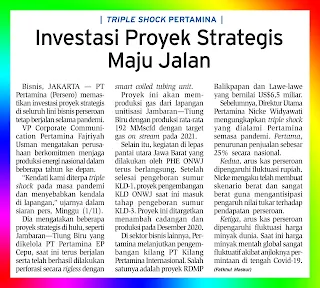Although the oil and gas industry is still challenging, the Special Task Force for Upstream Oil and Gas Business Activities or SKK Migas still targets 14 upstream projects to start operating this year.
SKK Migas Operations Deputy Julius Wiratno said that this year, there were 12 upstream oil and gas non-PSN (National Strategic Projects) projects that were targeted to start operating or onstream. The number is an increase of one project compared to last year's target.
"There will be 12 non-PSN projects on stream with a project value of US $ 354 million and the potential for additional oil production of 27,000 bpd and 492 MMscfd of gas," he said.
Meanwhile, the two PSN projects that will be onstream in 2021 are the Jambaran Tiung Biru project by PT Pertamina EP Cepu (PEPC) and the Tangguh Train-3 project by BP.
The Jambaran Tiung Biru project is projected to be onstream in the fourth quarter of 2021. The project work as of the third quarter of 2020 still reached 74.28% of the target of 88.28%.
Similar to the Tiung Biru Jambaran Project, the Tangguh Train-3 project is projected onstream in the fourth quarter of 2021. As of September 2020, the progress of Tangguh Train-3 onshore work has reached 88.27%, and offshore has reached 98.27%.
"Apart from the difficulties of the Covid-19 pandemic, we are still targeting onstream at the end of 2021," he said.
Although SKK Migas is optimistic that the work plan in the upstream oil and gas sector will proceed as planned, a number of challenges, particularly those affecting the project's economy, are still looming. The government is also considered to have to be more active so that a number of oil and gas projects whose work is constrained can be realized immediately.
So far, there are two upstream oil and gas projects that are still unclear because the company plans to release its participation, namely Shell in the Masela Block Abadi field project and Chevron in the Indonesia Deepwater Development (IDD) project.
Trisakti University teaching staff Pri Agung Rakhmanto explained that in the case of the Masela Block project, the government needs to be more active to play a role in obtaining gas buyers. Meanwhile, in the IDD project, middle ground and a compromise must be found in terms of project economics.
An observer of the energy economy from Gadjah Mada University Fahmy Radhi is of the opinion that the government should step in so that the Masela Block construction can be completed on time, including in land acquisition to build a pipeline network. This is an important part needed to distribute the gas produced from the Abadi field.
"The challenge is completing the construction and pipeline infrastructure for gas distribution from the Masela Block to consumers. With great prospects, it is not difficult for Inpex to find investors to replace Shell, "he said.
The Executive Director of the National Oil and Gas Companies Association (Aspermigas), Moshe Rizal Husin, assessed that the homework that the government still has to do is to revive the investment climate in the upstream oil and gas sector. Meanwhile, based on SKK Migas data, the realization of upstream oil and gas investment in 2020 only reached the US $ 10.21 billion, lower than the target of US $ 12.1 billion. For this year, SKK Migas is targeting upstream oil and gas investment of US $ 12.3 billion.
"There must be a significant breakthrough and commitment from the government that creates certainty. The oil and gas business is long-term and has a very large multiplier effect, ”said Moshe.
Moshe hopes that the condition of the upstream oil and gas industry this year can run better with stable oil prices at a level above the US $ 50 per barrel or even could improve to the level of US $ 60 per barrel in the third quarter of 2021.
KEEP PRODUCTION
In other developments, the development program in the Mahakam Block will run more aggressively in order to reduce the rate of natural production decline. SKK Migas has approved the work plan of PT Pertamina Hulu Mahakam (PHM) in 2021 with more drilling activities compared to 2020. Thus, production in the Mahakam Block in 2021 is expected to increase with more massive and aggressive optimization.
Deputy of Finance and Monetization of SKK Migas Arief S. Handoko said that if production from the Mahakam Block drops, domestic LNG production will also decline. However, PHM will get incentive approval so that production is maintained.
"The possibility of production stays, even increases. In addition, there is a new Merakes field that will contribute so that LNG production will increase, ”he explained.
Likewise, General Manager of PHM Agus Amperianto said that his party is optimistic that it can maintain production in the Mahakam Block by optimizing work in the field development operations that have been approved by SKK Migas.
"Currently, what is possible for Mahakam to do is how to survive in times of crisis," he said.
He added that this year there are a number of efficiency programs, including reducing the operating costs of the Mahakam Block effectively and efficiently. In addition, PHM will also strengthen operational activities through collaboration, strengthening knowledge management, and organizational transformation.
Based on the 2021 work program and budget (WP&B), PHE will carry out 73 development well drilling activities and two exploration wells drilling. Meanwhile, as of December 31, 2020, the realization of PHE's oil and gas production was still above the target.
Oil and condensate production was recorded at 26,363 bpd or 102% of the revised WP&B of 25,722 bpd. Meanwhile, gas production reached 606 MMscfd or 103% compared to the revised WP&B of 588 MMscfd.
Bisnis Indonesia, Page-4, Tuesday, Jan 5, 2021


















































